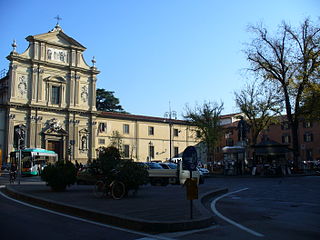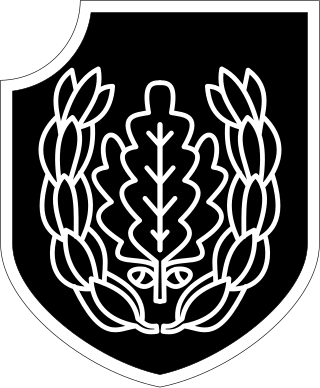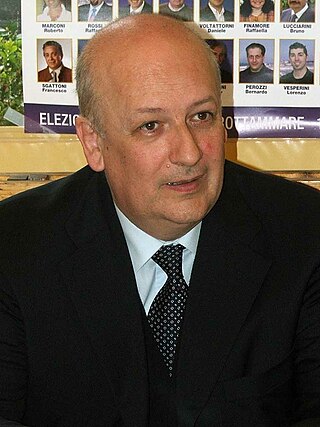
Fra Bartolomeo or Bartolommeo, also known as Bartolommeo di Pagholo, Bartolommeo di San Marco, Paolo di Jacopo del Fattorino, and his original nickname Baccio della Porta, was an Italian Renaissance painter of religious subjects. He spent all his career in Florence until his mid-forties, when he travelled to work in various cities, as far south as Rome. He trained with Cosimo Rosselli and in the 1490s fell under the influence of Savonarola, which led him to become a Dominican friar in 1500, renouncing painting for several years. Typically his paintings are of static groups of figures in subjects such as the Virgin and Child with Saints.

Lorenzo di Piero de' Medici, known as Lorenzo the Magnificent, was an Italian statesman, the de facto ruler of the Florentine Republic, and the most powerful patron of Renaissance culture in Italy. Lorenzo held the balance of power within the Italic League, an alliance of states that stabilized political conditions on the Italian Peninsula for decades, and his life coincided with the mature phase of the Italian Renaissance and the golden age of Florence. As a patron, he is best known for his sponsorship of artists such as Botticelli and Michelangelo. On the foreign policy front, Lorenzo manifested a clear plan to stem the territorial ambitions of Pope Sixtus IV, in the name of the balance of the Italian League of 1454. For these reasons, Lorenzo was the subject of the Pazzi conspiracy (1478), in which his brother Giuliano was assassinated. The Peace of Lodi of 1454 that he supported among the various Italian states collapsed with his death. He is buried in the Medici Chapel in Florence.

Piero di Lorenzo de' Medici, called Piero the Fatuous or Piero the Unfortunate, was the lord of Florence from 1492 until his exile in 1494.

The Lunigiana or Lunesana is a historical territory of Italy, which today falls within the provinces of Massa Carrara, Tuscany, and La Spezia, Liguria. Its borders derive from the ancient Roman settlement, later the medieval diocese of Luni, which no longer exists.

Pontremoli is a small city, comune former Latin Catholic bishopric in the province of Massa and Carrara, Tuscany region, central Italy.

Comano is a town and comune in the province of Massa and Carrara, Tuscany, Italy, of some 700 inhabitants.

Massa is a town and comune in Tuscany, central Italy, the administrative centre of the province of Massa and Carrara. It is located in the Frigido River Valley, near the Alpi Apuane, 5 km (3 mi) from the Tyrrhenian Sea.

Fosdinovo is a comune (municipality) in the Province of Massa and Carrara in the Italian region Tuscany, located about 110 kilometres (68 mi) northwest of Florence and about 15 kilometres (9 mi) northwest of Massa.

Licciana Nardi is a comune (municipality) in the Province of Massa and Carrara in the Italian region Tuscany, located about 110 kilometres (68 mi) northwest of Florence and about 25 kilometres (16 mi) northwest of Massa.

Giovanni Battista Naldini (1535–1591) was an Italian painter in a late-Mannerist style, active in Florence and Rome.

Museo Nazionale di San Marco is an art museum housed in the monumental section of the medieval Dominican convent of San Marco dedicated to St Mark, situated on the present-day Piazza San Marco, in Florence, a region of Tuscany, Italy.

The 16th SS Panzergrenadier Division "Reichsführer-SS" was a motorised infantry formation in the Waffen-SS of Nazi Germany during World War II.

Sandro Bondi is an Italian politician. He served as minister of culture from 2008 to 2011 in the fourth Berlusconi government.

Peter Chelsom is a British film director, writer, and actor. He has directed such films as Hector and the Search for Happiness, Serendipity, and Shall We Dance? Peter Chelsom is a member of the British Academy, the American Academy, The Directors Guild of America, and The Writers Guild of America.

The House of Malaspina was a noble Italian family of Longobard origin that descended from Boniface I, through the Obertenghi line, that ruled Lunigiana from the 13th to the 14th centuries, and the marquisate of Massa and lordship of Carrara since the 14th century.
The Vinca massacre was a massacre carried out near Fivizzano, Tuscany, by the German 16th SS Panzergrenadier Division from 24 to 27 August 1944 in which 162 Italian civilians were killed.
The San Terenzo Monti massacre, sometimes also referred to as the Bardine massacre or Bardine San Terenzo massacre, was a massacre carried out near Fivizzano, Tuscany, by the German 16th SS Panzergrenadier Division from 17 to 19 August 1944 in which 159 Italian civilians were killed.

The San Gallo Annunciation is an oil-on-panel painting by Andrea del Sarto, executed c. 1513–1514, now in the Palatine Gallery in Florence.

Security is a 2021 Italian thriller-mystery film co-written and directed by Peter Chelsom and starring Marco D'Amore and Maya Sansa. Chelsom's first foreign language film, it is based on the novel with the same name by Stephen Amidon.





















